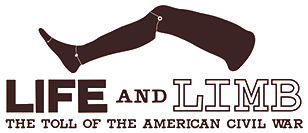
Class 4: Symptoms of Sacrifice: Surgeons
Introduction:
This class broadens out from the historians’ interpretation of wounding and its impact to consider the medical response to Civil War soldiers’ injuries, a response that is implied to lie behind our interpretation of soldiers’ experiences but rarely positioned at the center of our understanding of the Civil War or its wounded. Extracts from the medical writings of Civil War surgeon S. Weir Mitchell and from the diary of a front-line Union surgeon, Frances Wafer, are juxtaposed with secondary readings that explore the medical treatment of physical wounds and the broader implications of soldiers’ symptoms. As for Class 2, students will benefit from Frank Freeman’s overview of the Union and Confederate medical systems before turning to the more specific readings provided by Charles Wooley, who discusses the specifics of what became known as ‘soldier’s heart’ in the Civil War era; R. Gregory Lande, an expert in forensic psychiatry, who helps us understand both the practical and diagnostic challenges surgeons faced in the course of the Civil War; and Michal Flannery, who provides a pertinent analysis of just some of the tensions surrounding appropriate medical treatment at this time.
Students will be best able to contextualize the readings for this class if these are used in conjunction with the following sections from the exhibition: The “Wounds of War” in Horrors of War, and “Under the Knife”, and “The Limits of Medicine” in Maimed Men.
Readings:
Primary:
Mitchell, S. Weir. Injuries of Nerves and their Consequences. Philadelphia: Lippincott, 1872, Chap. XIV.
___, George R. Morehouse and William W. Keen. Gunshot Wounds and Other Injuries of Nerves. Philadelphia: Lippincott, 1864, Chap. 1.
Wafer, Frances M. A Surgeon in the Army of the Potomac. Edited by Cheryl A. Wells. Montreal and London: McGill-Queens University Press, 2008, Chap. 5 and Epilogue.
Secondary:
Flannery, Michael A. “Another House Divided: Union Medical Service and Sectarians During the Civil War.” In The Journal of the History of Medicine and Allied Sciences 54 (1999): 478-510.
Freemon, Frank R. Gangrene and Glory: Medical Care during the American Civil War. Urbana and Chicago: University of Illinois Press, 2001, Chaps. 7 and 8.
Lande, R. Gregory. Madness, Malingering and Malfeasance: The Transformation of Psychiatry and the Law in the Civil War Era. Washington, D.C.: Brasseys, 2003, Chaps. 5 and 6.
Wooley, Charles F. The Irritable Heart of Soldiers and the Origins of Anglo-American Cardiology. Aldershot: Ashgate, 2002, Chaps. 1-3.
Discussion Questions:
- S. Weir Mitchell was the first to identify what became known as ‘phantom limb’ syndrome, a phenomenon he described in Injuries of Nerves and their Consequences. How crucial was his experience of the Civil War in his thinking? What evidence does Injuries provide in this regard?
- What was ‘irritable heart’ syndrome, and what influenced Da Costa’s changing diagnosis of this condition? What does this tell us about the impact of the Civil War on its combatants and on its clinicians?
- How accurate is Flannery’s description of Union medical services as a ‘house divided’ during the Civil War? To what extent did these divisions impact on the medical treatment combatants received?


